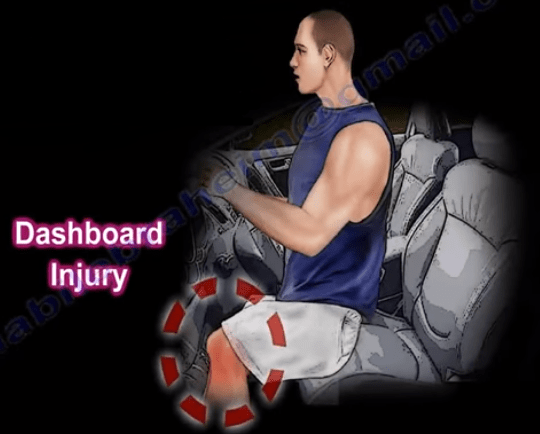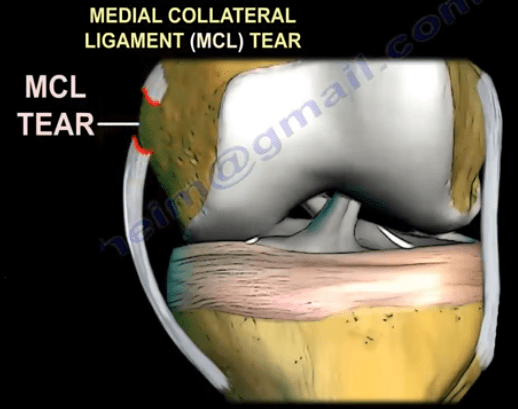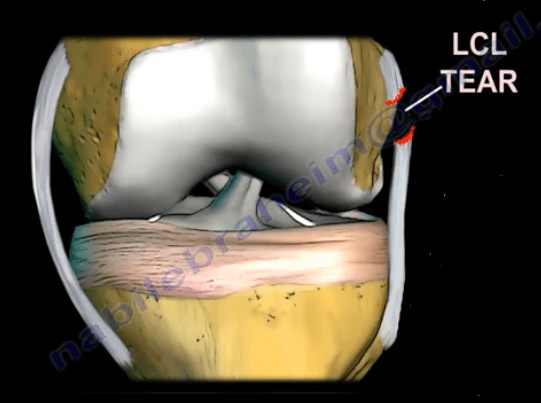A history of dashboard injuries or a fall onto a plantar flexed foot will cause a posterior cruciate ligament (PCL) injury. A PCL injury is examined by performing the posterior drawer test. The posterior drawer test will be done in 70-90 degrees of flexion. The physician will want to watch for the sag. The amount of translation in relation to the femur is observed. In general, if the knee is bent or the foot is plantar flexed, this can cause a PCL injury. However, if the knee is extended, in valgus or if there is a hyperextension injury, this can cause an ACL injury.
A Noncontact pivoting injury with large swelling of the knee after hearing a "POP" is usually an anterior cruciate ligament (ACL) injury. The middle genicular artery will be injured and there will usually be hemorrhaging inside the knee joint. The Lachman's test is used to diagnose an injury to the ACL. The Lachman's test is done by bending the knee to about 20-30 degrees of flexion. Then, the tibia is reduced and when the physician pulls it forward, the instability can be seen. At this point, the tibia is subluxed forward. The Pivot Shift test is also done for ACL tears, but is usually reserved for chronic ACL tears. The Pivot Shift Test is different from the Lachman's Test. When the knee is straight, the lateral tibial plateau will be subluxed in extension. In 20-30 degrees of flexion, it will be reduced by the iliotibial band. The physician should notice a palpable clunk on the outside of the knee as the tibia reduces.

If the patient has a history of a fall onto a dorsiflexed foot, the patient may have a patellar fracture (Fall onto kneecap). The patella can fracture due to a direct impact injury or an indirect injury due to eccentric contraction. Twisting injuries may cause a meniscal injury. There will be some swelling and pain that is worse with twisting or squatting motions. The patient may complain of their knees locking. The examination will show joint line tenderness which is specific to meniscal injuries. The McMurray's test is used to diagnose the presence of a meniscal tear. A painful click may be obtained as the knee is brough from flexion to extension in either internal or external rotation. There will be a "click" or "Pop" with valgus plus external rotation with injury to the medial meniscus. A "click" or "pop" sensation felt during internal rotation and extension of the knee, indicates an injury to the lateral meniscus.
Pain in the knee around the patella with climbing stairs or during sitting may be a sign of a patella problem. The Lateral Patellar Apprehension Test is performed to check the knee for symptoms of a dislocating or subluxing patella. With the finger placed on the patella medially, the physician will try to push on the patella laterally. If this causes pain and apprehension, then the test is considered positive. Isolated injuries of the posterolateral corner are rare and often cause instability and varus thrust. By performing the Dial Test, you can detect if there is an isolated or combined injury of the posterolateral corner of the knee. In an isolated posterolateral corner injury, the Dial Test will be positive at 30 degrees of flexion. It is better if the test is done with the patient lying prone. It is important for the physician to compare both sides. Flexion at the 90 degree angle will test the posterior cruciate ligament (PCL) for injury. More than 10 degrees of external rotation asymmetry at 30 degrees and at 90 degrees is consistent with posterolateral corner and PCL injury.

Pain on the inside of the knee with a "popping" sound after a blow to the outside of the knee, is probably a sign of a medial collateral ligament (MCL) injury. The typical mechanism of injury of the MCL is due to a valgus and external rotation force. A proximal tear of the MCL usually heals well, and is the most common location for a tear. The MCL should be examined with the Valgus Stress Test (30 degrees of flexion). The valgus stress test at 30 degrees of flexion=, tests the superficial part of the medial collateral ligament (MCL). If the MCL appears to be lax at 0 degrees of extension, then this will signal a combine injury (MCL plus other ligaments and possibly a posterior capsule injury).
Lateral collateral ligament (LCL) injuries result from a varus force across the knee. A contact injury, such as a direct blow to the medial side of the knee, or a noncontact injury, such as a hyperextension stress, which may result in a varus force across the knee injuring the LCL. The LCL should be examined with the Varus Stress Test at 30 degrees of flexion. With the LCL isolated and the knee flexed to 30 degrees, move the knee from side to side to assess for stability of the knee.

If the patient has a history of knee injuries with a neurovascular deficit, then the physician should consider a knee dislocation. If the patient has a medial tibial plateau fracture, think of a knee dislocation and examine the patient carefully for the integrity of the circulation